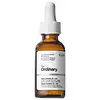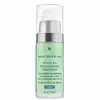What's inside
What's inside
 Key Ingredients
Key Ingredients

 Benefits
Benefits

 Concerns
Concerns

No concerns
 Ingredients Side-by-side
Ingredients Side-by-side

Water
Skin ConditioningGlycerin
HumectantIsononyl Isononanoate
EmollientPropylene Glycol
HumectantAzelaic Acid
BufferingNiacinamide
SmoothingSqualane
EmollientAlpha-Arbutin
AntioxidantAmmonium Polyacryloyldimethyl Taurate
Emulsion StabilisingHydrogenated Polyisobutene
EmollientSilica Silylate
EmollientHydroxyacetophenone
AntioxidantSodium Hyaluronate
HumectantCaprylyl Glycol
EmollientHydroxyethyl Acrylate/Sodium Acryloyldimethyl Taurate Copolymer
Emulsion StabilisingSodium Hydroxide
BufferingOlea Europaea Leaf Extract
PerfumingParfum
MaskingButylene Glycol
HumectantRosmarinus Officinalis Leaf Extract
AntimicrobialCitrus Grandis Fruit Extract
AstringentSodium Benzoate
MaskingCucumis Sativus Fruit Extract
EmollientSorbitan Isostearate
EmulsifyingPolysorbate 60
EmulsifyingBenzyl Benzoate
AntimicrobialThymus Vulgaris Flower/Leaf Extract
MaskingLactic Acid
BufferingBenzyl Alcohol
PerfumingAlpha-Isomethyl Ionone
PerfumingLinalool
PerfumingPotassium Sorbate
PreservativeCitronellol
PerfumingMorus Alba Root Extract
BleachingCI 19140
Cosmetic ColorantCI 42090
Cosmetic ColorantTocopherol
AntioxidantWater, Glycerin, Isononyl Isononanoate, Propylene Glycol, Azelaic Acid, Niacinamide, Squalane, Alpha-Arbutin, Ammonium Polyacryloyldimethyl Taurate, Hydrogenated Polyisobutene, Silica Silylate, Hydroxyacetophenone, Sodium Hyaluronate, Caprylyl Glycol, Hydroxyethyl Acrylate/Sodium Acryloyldimethyl Taurate Copolymer, Sodium Hydroxide, Olea Europaea Leaf Extract, Parfum, Butylene Glycol, Rosmarinus Officinalis Leaf Extract, Citrus Grandis Fruit Extract, Sodium Benzoate, Cucumis Sativus Fruit Extract, Sorbitan Isostearate, Polysorbate 60, Benzyl Benzoate, Thymus Vulgaris Flower/Leaf Extract, Lactic Acid, Benzyl Alcohol, Alpha-Isomethyl Ionone, Linalool, Potassium Sorbate, Citronellol, Morus Alba Root Extract, CI 19140, CI 42090, Tocopherol
 Reviews
Reviews

Ingredients Explained
These ingredients are found in both products.
Ingredients higher up in an ingredient list are typically present in a larger amount.
Alpha-Arbutin is made from hydroquinone and glucose. It may also be derived from the fermentation of soybeans.
This ingredient an antioxidant, meaning it helps protect your skin cells against damage.
Studies show this ingredient helps improve hyperpigmentation and fade discoloration.
Alpha-Arbutin may be used with other ingredients that help with hyperpigmentation. These ingredients include retinol, Vitamin C, niacinamide, and tranexamic acid.
Learn more about Alpha-ArbutinLactic Acid is another well-loved alpha hydroxy acid (AHA). It is gentler than glycolic acid but still highly effective.
Its main role is to exfoliate the surface of the skin by loosening the “glue” that holds dead skin cells together. Shedding those old cells leads to smoother, softer, and more even-toned skin.
Because lactic acid molecules are larger than glycolic acid, they don’t penetrate as deeply. This means they’re less likely to sting or irritate, making it a great choice for beginners or those with sensitive skin.
Like glycolic acid, it can:
Lactic acid also acts as a humectant (like hyaluronic acid). It can draw water into the skin to improve hydration and also plays a role in the skin's natural moisturizing factor (NMF) in the form of sodium lactate.
Studies show it can boost ceramide production to strengthen the skin barrier and even help balance the skin’s microbiome.
To get results, choose products with a pH between 3-4.
Lower strengths (5-12%) focus on surface exfoliation; higher strengths (12% and up) can reach deeper in the dermis (deeper, supportive layer) to improve skin texture and firmness over time.
Though it was originally derived from milk, most modern lactic acid used in skincare is vegan. It is made through non-dairy fermentation to create a bio-identical and stable form suitable for all formulations.
When lactic acid shows up near the end of an ingredient list, it usually means the brand added just a tiny amount to adjust the product’s pH.
Legend has it that Cleopatra used to bathe in sour milk to help reduce wrinkles.
Lactic acid is truly a gentle multitasker: it exfoliates, hydrates, strengthens, and brightens. It's a great ingredient for giving your skin a smooth, glowing, and healthy look without the harshness of stronger acids.
Read more about some other popular AHA's here:
Learn more about Lactic AcidWater. It's the most common cosmetic ingredient of all. You'll usually see it at the top of ingredient lists, meaning that it makes up the largest part of the product.
So why is it so popular? Water most often acts as a solvent - this means that it helps dissolve other ingredients into the formulation.
You'll also recognize water as that liquid we all need to stay alive. If you see this, drink a glass of water. Stay hydrated!
Learn more about Water